
Lamborghini vs. De Tomaso chasing the ultimate thrill. Can crossbreed Pantera humble pedigree Countach? Wildest Wedges Pantera takes on Countach for the supercar crown. Blue collar or blue blood? Can a £75k De Tomaso hold a candle to Lamborghini’s £1m masterpiece. Is a £1m Lamborghini really worth a dozen times more than a De Tomaso? Greg MacLeman unleashes Pantera and Countach in search of the greatest ’70s supercar. Photography Julian Mackie.
Imagine a visitor from another world with no prior knowledge of the intricacies of British politics stumbling across David Miliband standing in the road. Then, drawing alongside, his brother Ed. From a distance the similarities are plain to see, but take a few steps closer and, despite their family resemblance, the two could not be more different. Like screaming and yawning – only there’s nothing boring about either of these game-changing supercars.
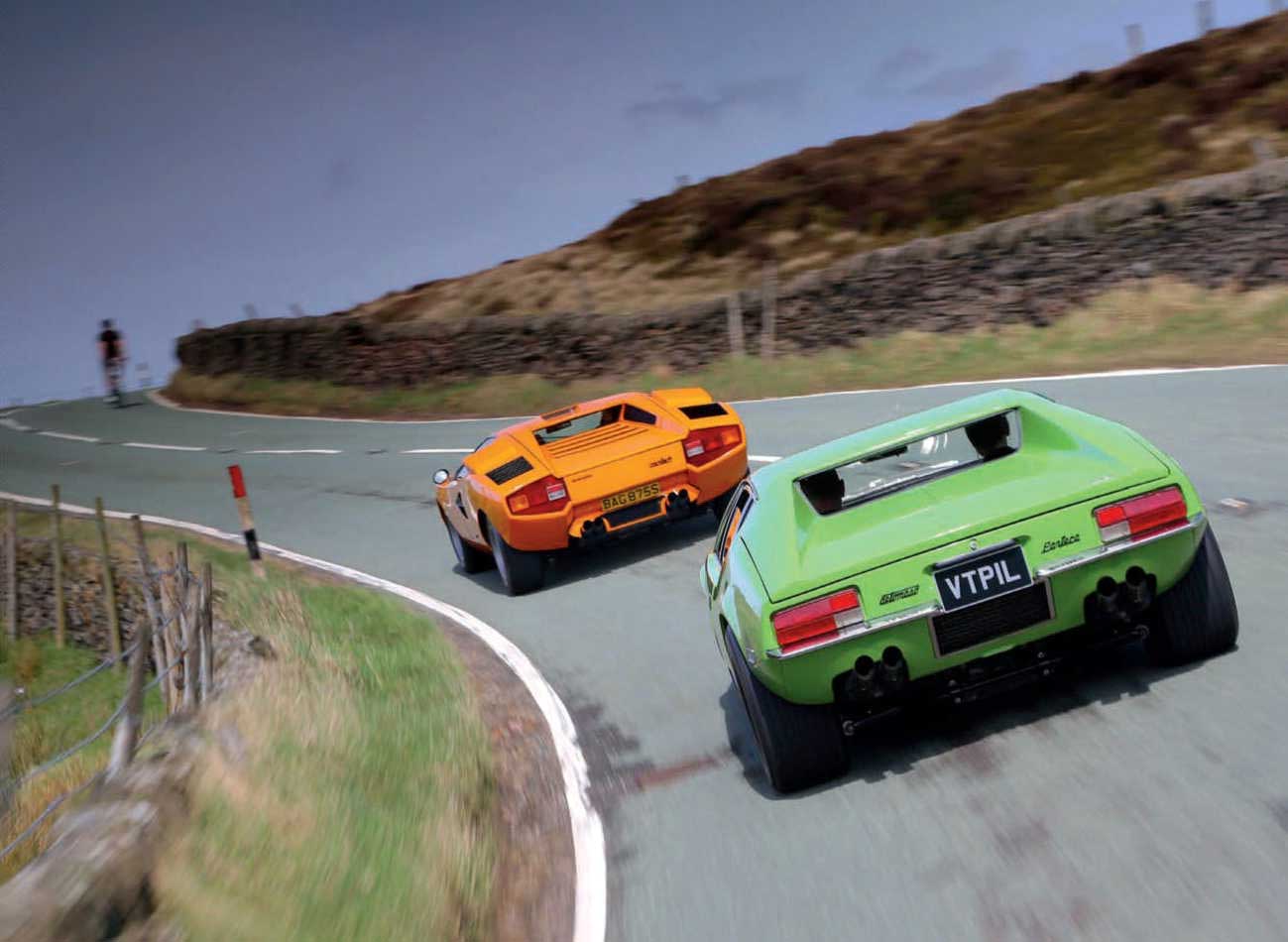
Lamborghini Countach LP400 vs. De Tomaso Pantera
By the late 1960s, Lamborghini had taken a comprehensive lead over De Tomaso in the hunt for ever-increasing top speeds. With the Miura, Sant’Agata was the reigning champion, while its rival was reeling from the perceived failure of the incredibly beautiful yet dynamically challenged Mangusta. As a result, it was all to play for at the turn of the next decade.
The Pantera project began as a marriage of convenience between Argentine-born Alejandro De Tomaso – who controlled Ghia and Vignale – and Ford, which desperately required a halo sports car with which to take on the Chevrolet Corvette. The Blue Oval duly offered De Tomaso a plentiful supply of V8s, pledging $2m in financing as well as access to its network of Lincoln-Mercury dealerships. The schedule was tight, though, and when the Tom Tjaarda-penned Pantera went on display at the 1971 New York Auto Show it was far from a finished product.

Lamborghini Countach LP400 vs. De Tomaso Pantera
Early examples were plagued by issues ranging from overheating to air-conditioning units devoid of refrigerant, each car needing a considerable number of man-hours to put faults right when it arrived from Modena at Bill Stroppe’s shop in Long Beach, California. Yet despite the questionable quality control and a wary reception from the motoring press, the Pantera was light years ahead of the Mangusta – thanks in large part to its Giampaolo Dallara-engineered chassis, courtesy of the former Sant’Agata man who had helped to mastermind the Miura.
Lamborghini’s task was arguably more challenging: to improve upon the model that had almost single-handedly created the supercar segment and to fend off a resurgent Ferrari, which had its 365GT4 Berlinetta Boxer in the pipeline. Sant’Agata fired its opening salvo at the Geneva Salon in March 1971, where it revealed the extraordinary LP500 concept – the car that would become the Countach LP400. Perhaps even more than the Pantera, the gestation of the new model was a complicated process that involved a change of tack from the semi-monocoque of the prototype to a tubular spaceframe chassis reminiscent of a Porsche 917, while the longitudinally mounted V12 was reduced in capacity from five litres to four.
The wedge was king in 1970s car design, but to describe either of these two cars as such would do a great disservice to both Gandini and Tjaarda. The Lamborghini in particular seems to evolve under your gaze, straight lines and angular sharpness giving way to softly sweeping curves. You can almost visualise the pencil swooping over the draughtsman’s table as you trace the undulating outline of the bonnet and the Coke-bottle swage line down each flank.
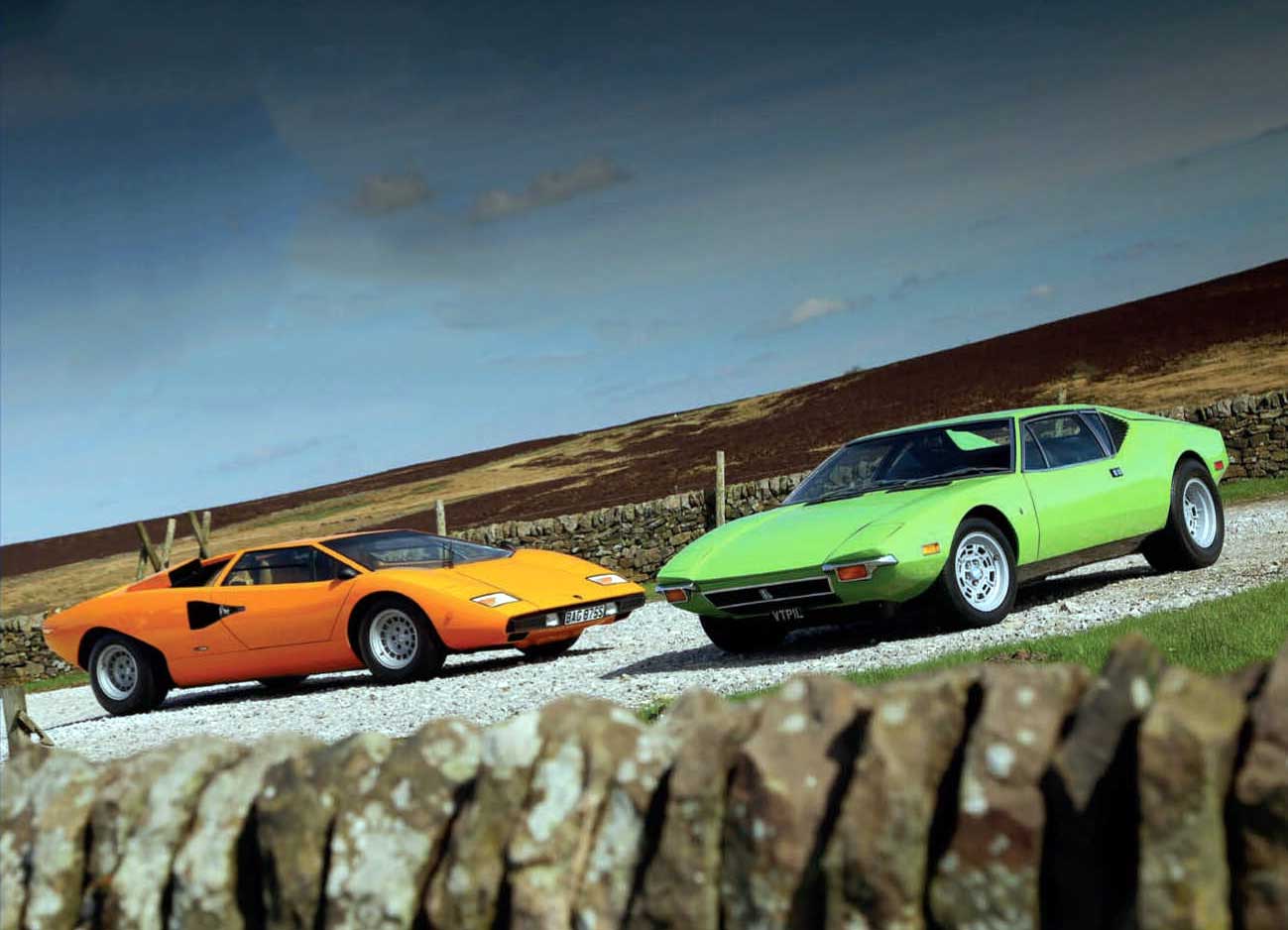
Lamborghini Countach LP400 vs. De Tomaso Pantera. Angular wedge styling and lurid paintwork place our supercar pairing squarely in the ’70s, but their pace can still trounce that of many a modern vehicle.
Perhaps Gandini’s greatest triumph was the slashed rear arches that add a sense of motion to the styling, paired with black NACA ducts and the cavernous air scoops that were added to the otherwise largely unchanged LP500 concept. The Countach is a different car from each angle – from the front, sleek arrowhead; the tail, pure muscle; and from the side, cruise missile – and in 1974 the wild scissor doors must have seemed like something straight out of a science fiction film. It’s a design that defined a generation of supercars, influencing the visual language of every Lamborghini to leave the factory since. In contrast, the Pantera, perhaps unsurprisingly, boasts a more transatlantic flavour.
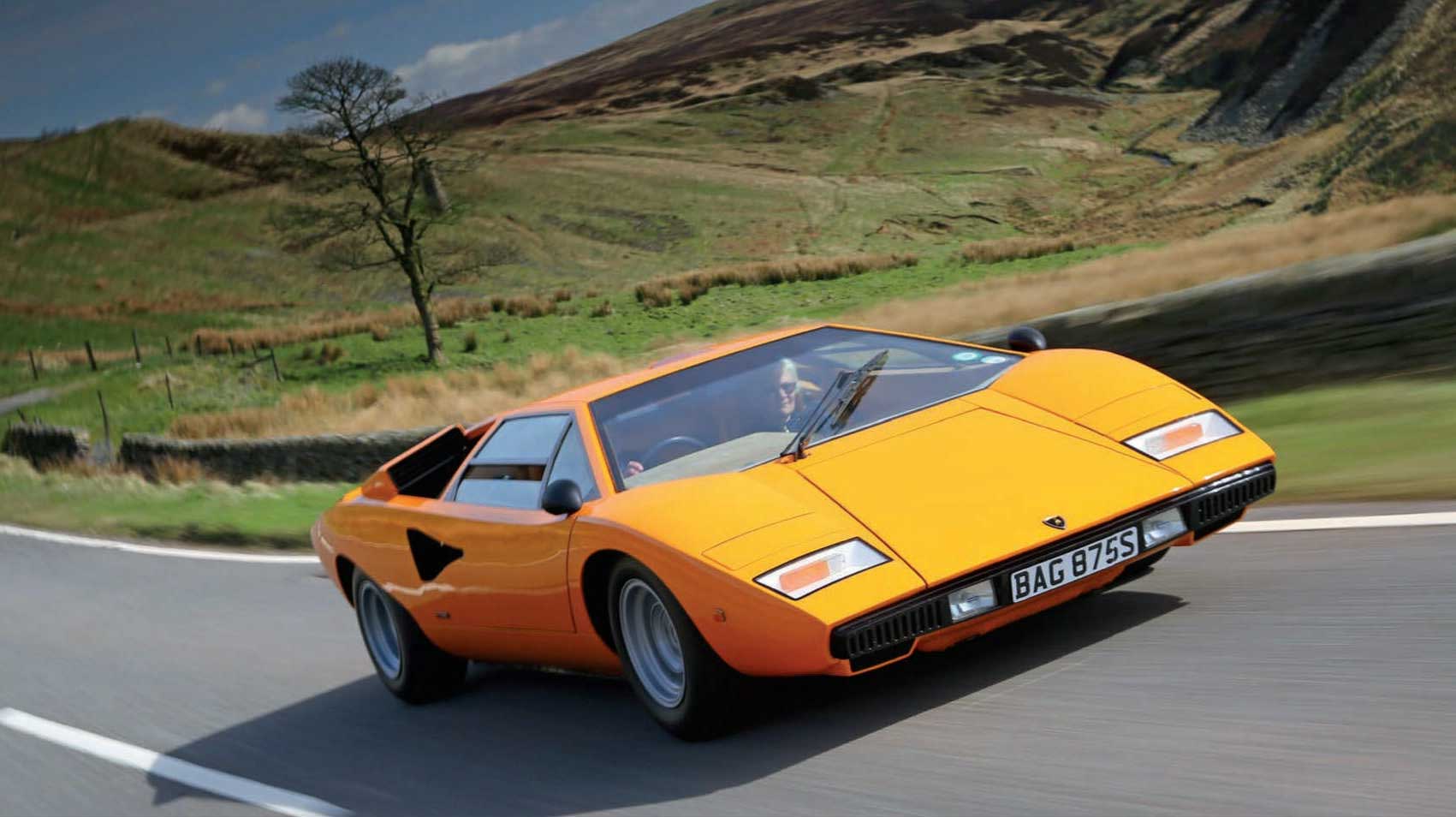
Lamborghini Countach LP400 road test
Where the Countach is all-Italian supercar, the De Tomaso has muscle car overtones, with bulging, tall rear tyres akin to a top fuel dragster and a meeting of side window and rear wheelarch that brings to mind – if you squint hard enough – Mustang Mach 1 and Buick Skylark.
It’s also clear that the De Tomaso was built, at least in part, to fend off the Richard Teague-styled AMC AMX/3 – although that threat ultimately proved to be empty.
Both Countach and Pantera share a striking similarity from behind, with each tail slanting aggressively and sharing a flat deck leading to a barely functional vertical rear window. In a rare nod to practicality, ‘our’ Lamborghini has small door mirrors – a feature notably absent from the Pantera. In truth, though, regardless of which car you’re driving you might as well have a passenger carrying a red flag should you ever need to reverse. Or, in the case of the Countach, master the art of the ‘pitlane prowl’ and back up with the driver’s door raised.
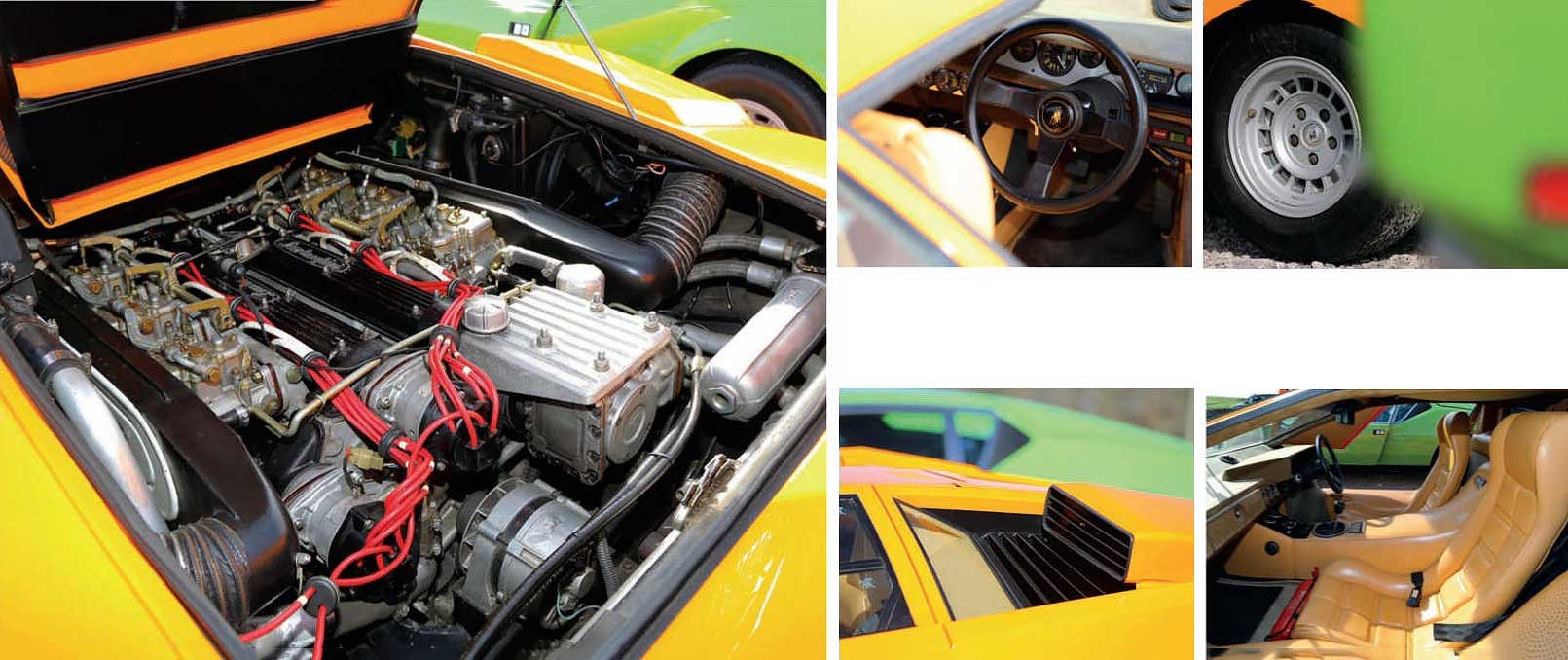
Lamborghini Countach LP400 road test. Clockwise: even today, few cars can match the sheer drama of the Lamborghini; small three-spoke wheel with Raging Bull centre; inlets duct cooling air to vast engine; Campagnolos and period-correct XWXs; V12 was carried over from the Miura, but is mounted longitudinally in Countach. From top: Lambo’s cabin is pure theatre with highly stylised seats and vast transmission tunnel; De Tomaso remarkably conventional inside; both cars provide huge drama out on the public road.
In engineering terms, the Lamborghini is a curious mix of old and new; a cutting-edge lightweight aluminium body draped over a complex spaceframe and mated to a four-litre V12 – based on that of the Miura – sitting amidships. Unlike its transverse-engined predecessor, the LP400’s transmission is located ahead of the engine between driver and passenger; power is channelled forward to the gearbox and then back – via a shaft passing through the sump– to the differential, and on to each rear wheel. As well as allowing for a remarkably short wheelbase, the layout negates the need for a lengthy gear linkage, resulting in a pure and delightfully mechanical shift.
In contrast, DeTomaso opted to place the ZF transmission behind the differential, with the engine ahead of the axle line. ‘Students of race car design will immediately notice that all major components are in the right place,’ noted Road Test’s John Ethridge in period, and in many ways the Pantera proved a spiritual successor to the GT40, proving to be a useful tool in Group 4 racing. Its sub-structure closely matched that of Ford’s Le Mans winner, too, while the drag coefficient was found to be practically identical.
At its heart, the Pantera boasts the fruit of De Tomaso’s partnership with the Blue Oval – a thumping 351cu in (5.8-litre) ‘Cleveland’ V8. If the Lamborghini’s engine is a scalpel, then the Pantera’s is a sledgehammer; the pushrod unit is as simple as they come, but with that simplicity come reliability, tunability and tractability that helped the model to endure.
You instantly know where you stand when you hear the DeTomaso’s V8 burble, unlike its rival. Any sense of familiarity afforded by the steering being on the correct side of the Countach – it’s one of only 17 right-hand-drive examples built – soon evaporates as you lift the bonkers door and slide into the outlandish, high-backed leather seat.
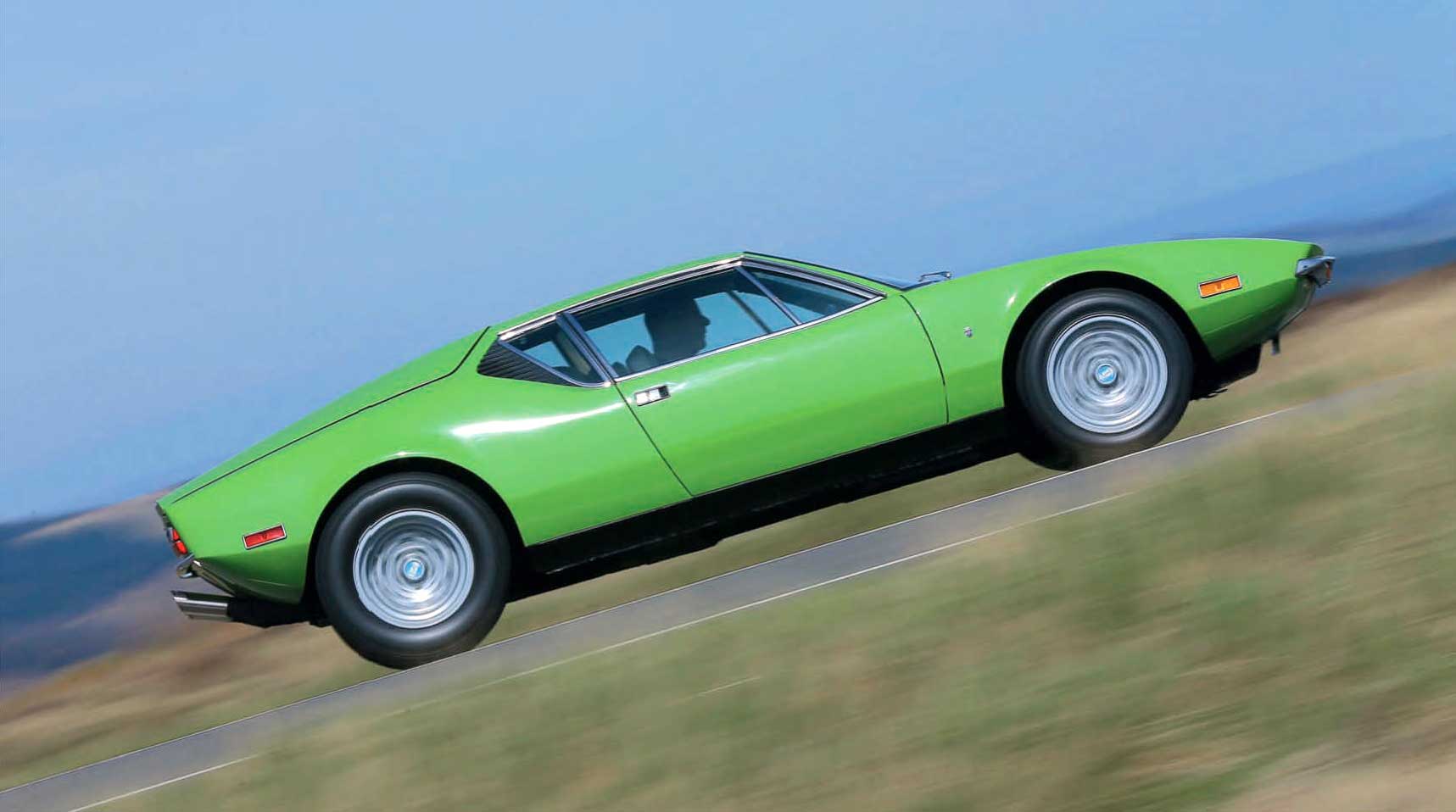
De Tomaso Pantera road test
Though more reserved than that of a Miura, the cabin reeks of Italian style and 1970s flamboyance, complete with an upright driving position and a pedal arrangement that demands careful placing of penny loafers.
Turning the key kicks the fuel pump into action, a series of clicks and whirrs accompanying the priming of six twin-choke sidedraught Webers, the engine bursting into life with a tickle of the throttle. Fly-off handbrake released, the gearlever slots into the dogleg first with ease and you release the clutch pedal, which has a high biting point and long travel. Judicious use of revs prevents stalling, which owner Stephen Ward says can be a problem if you’re not used to the car’s foibles. Newcomers can expect an ungainly and nervous start before they and the Countach become better acquainted – horse riders will know the sensation well – but confidence grows with each shift through the stiff, purposeful ’box. Being more aggressive with the throttle is rewarded with a V12 roar accompanied by great lungfuls of air and fuel being gulped by the intakes.
Shallow wheelarches limit suspension travel, but even on bumpy roads the Countach absorbs imperfections beautifully, cornering flat and encouraging you to press on through long sweepers before burying the throttle to power up approaching hills. Blind crests provide the opportunity to test the brakes, which show their age but haul up the LP400 straight and true.

De Tomaso Pantera road test. Clockwise: aggressive wedge profile was the work of American designer Tom Tjaarda; ‘Cleveland’ V8 is set well forward; stylish Campagnolo alloy wheel; upside-down Alfa GTV lights look bespoke; cockpit is dominated by hooded dials, with further gauges in centre console angled towards driver.
After a while we pull over and hand the controls back to the owner; he turns the volume up to 11 with a masterclass in double-declutching, firing through the gearbox like a pro and pressing the needle to the far reaches of the dial – a process in which he visibly delights. The blinding speed of the Countach eclipsed all its rivals in period, from Ferrari Boxer to Porsche 911 turbo, and 40 years later you could still drive all year without coming across anything quicker. While the Pantera joins the line of cars soon to become a speck in the Lamborghini’s rearview mirror, it puts up a better fight than most.
The De Tomaso tops out at around 139mph, but holds up well under real-world conditions, being just two tenths of a second slower to 60mph. Unlike the Lamborghini, which sounds remarkably subdued at tickover, the Pantera’s quad exhausts emit a sinister V8 rumble at idle, rising to a deafening crescendo when the hammer is really down. Winding the car up quickly can be a touch frustrating initially, due to a slow shift from first to second and then third to fourth, but for anything other than a 0-60mph dash the leisurely gearchange and long throw shouldn’t bother you. The Pantera’s greatest party trick is its ability to be driven at walking pace and through heavy traffic with all the ease of a modern-day hatchback, great waves of torque wafting it along in almost any gear.
Its handling qualities are a huge improvement over the Mangusta, but trail its Italian rival on the undulating and twisting roads of the Peak District. As noted by period road testers, the Pantera is prone to understeer when pushing hard, and it’s a trait that surfaces during our photo-shoot, though not an altogether unwelcome one. It’s a process that happens gradually, and is far more forgiving than many midengined cars, which can break away with little warning – the last thing you want shortly after glancing at the insurance statement and seeing what each of our duo would cost to replace.
Though there’s a clear disparity in the value of the two cars – at around £75k, you’d have to sell a dozen Panteras to raise the funds for an LP400 – both are appreciating, and each of our custodians was wise enough to open his wallet at the right time. DeTomaso owner Michael Fisher explains: “Prices were rising so quickly, we decided that if we didn’t buy one then it might never happen.”
Soaring values have also affected LP400 prices, but owner Stephen Ward is quick to point out the relativity of classic values: “When I bought the Countach in South Africa 20-plus years ago, the money would have got me a detached house with a swimming pool and two-car garage in a nice area. Now? It would get me about the same.”
But which of these exotics would win a place in your garage depends on much more than bank balance alone. One offers true supercar performance that is unlikely to be fully tested on the road, along with a sense of drama and theatre that have seldom been repeated. The other is a problem child come good, an uncommonly successful blend of Italian styling and American engineering that seems greater than the sum of its parts. The LP400is a car that made more sense in the days of Mel Nichols’ continental blasts for Car on empty autostradas, while the Pantera, damned by Road &Track as ‘another high-priced kit car’, seems a more attractive proposition than ever before.
The technologically superior Lamborghini certainly lives up to every expectation born of posters on bedroom walls and dog-eared decks of Top Trumps, but the more time I spend with the Pantera the more I am reminded of a quote attributed to Leonardo Da Vinci: la semplicità è l’ultima sofisticazione – simplicity is the ultimate sophistication.
‘A SINISTER V8 RUMBLE RISES TO A DEAFENING CRESCENDO WHEN THE HAMMER IS DOWN’
‘IF THE LAMBORGHINI’S ENGINE IS A SCALPEL, THEN THE PANTERA’S FORD V8 IS A SLEDGEHAMMER’
TECHNICAL DATA FILE LAMBORGHINI COUNTACH LP400
Sold/number built 1973-’1978/150
Construction tubular steel spaceframe with aluminium bodywork
Engine mid-mounted, all-alloy 3929cc V12 with dohc per bank and six twin-choke Weber 45 DCOE carburettors
Max power 375bhp @ 8000rpm / DIN
Max torque 268lb ft @ 5000rpm / DIN
Transmission five-speed manual, RWD
Suspension independent, double wishbones, coil springs, anti-roll bar; fully adjustable
Steering rack and pinion
Brakes dual-circuit ventilated discs, with servo
Wheels and tyres 14in Campagnolo alloys with 205/70 (front) and 215/70 (rear) VR14 Michelin XWXs
Length 13ft 7in (4140mm)
Width 6ft 2in (1880mm)
Height 3ft 6in (1067mm)
Wheelbase 8ft (2438mm)
Weight 2347lb (1060kg)
0-60mph 5.6 secs
Top speed 175mph
Mpg 10-14
Price new £17,890.98 (1975)
Price now £1,000,000+
TECHNICAL DATA FILE DETOMASO PANTERA
Sold/number built 1971-’1992/7260
Construction steel monocoque
Engine all-iron 5763cc overhead-valve V8, fed by single four-barrel Autolite carburettor
Max power 310bhp @ 5400rpm / DIN
Max torque 325lb ft @ 3600rpm / DIN
Transmission five-speed ZF transaxle, driving rear wheels
Suspension independent by unequal-length wishbones, coil springs, anti-roll bars
Steering rack and pinion
Brakes dual circuit ventilated discs
Wheels and tyres 15in Campagnolo alloys with 185/70 R15 tyres (front) and 205/70 R15 (rear)
Length 13ft 11in (4241mm)
Width 5ft 1in (1803mm)
Height 3ft 71/2in (1092mm)
Wheelbase 8ft 3in (2514mm)
Weight 3145lb (1426kg)
0-60mph 5.8 secs
Top speed 139mph
Mpg 17
Price new £6578
Price now £75,000+
THE OWNER Stephen Ward
“When I first heard Maria Callas sing Vissi d’Arte, I became an opera fan, and when I saw the Countach I knew I had to own it – it changed my life,” explains Ward, who founded South Africa’s Lamborghini Club. “It was one of two cars imported there,” he recalls and I bought it more than 20 years ago from a guy I’d never met. Now we are firm friends – he’s asked me to drive to Maranello with him in his Ferrari. I scraped together every penny I had and maxed-out all my credit cards to buy the Countach – it ruined me financially for years! But it’s love, you have to have it.
“My mother was old-school and lived through the Blitz, and when I bought it she didn’t speak to me for three weeks. She said that I should have put my money in the bank and saved it for a rainy day.”
“The Lamborghini is just a masterpiece of design,” he enthuses. “It’s not something to drive through London, but on the right day, in the right mood, it’s sheer driving Nirvana. Some of the cogs – it’s like I know them!
“It’s very Italian – a real screamer, even by today’s standards. But it’s been amazingly reliable too. We’ve driven it from York to Goodwood, with all our clothes, clobber for the party, tools and oil, and even a car cover stashed inside.”
THE OWNER Michael Fisher
“I went to Lake Lugano, Switzerland when I was about 14 and saw one outside a hotel,” says Fisher. “To a lad from a northern mining town, a Porsche was something, let alone a car like this. I knew that I had to have one.” “We met De Tomaso guru Mike Drew at Concorso Italiano, and he helped us find a car. It was dragged out of a California barn, where it had been sitting since 1978 up to its hubs in sand. Roger Brotton carried out the restoration. It takes a bit of warming up and reverse can be tricky, but it rolls along quite smoothly and it’s a thing of absolute beauty. I love the designs of that period – it was the last time that people really pushed – but the most remarkable thing is the noise!”
The alternatives
FERRARI 365GT4 BB
Anyone in the market for a Miura – or those holding out for a Countach – would have given Ferrari’s Boxer a close inspection at its 1971 debut. Following on from the Dino, it was one of the first mid-engined Ferrari road cars, and a 4.4-litre flat- 12 gave it true supercar levels of performance. It cost a whisker less than the Lambo (and is about £350k today), while the Leonardo Fioravanti styling was more restrained than the otherworldly LP400.
PORSCHE 911 TURBO 930
The first turbocharged 911 came along in 1975, upping the model’s power output to a previously unheard of 260bhp, which increased to 300bhp with the arrival of the 3.3-litre variant in 1978. Despite fewer cylinders than the Countach and Pantera, in the right hands the Porsche out-accelerated both. At roughly similar money to the De Tomaso (£80,000+), this German coupé is as difficult to overlook today as it was in period.
MASERATI BORA
The Trident’s first foray into the world of mid-engined road cars had Lamborghini firmly in its sights, but is today around one fifth of the price of an LP400 at £150-200k. At its heart was a 4.7-litre quad-cam V8 from the 450S, while the styling was masterminded by Giugiaro. It gave away power and sprint speed to both of our duo, but it boasts a vast cabin and a rear window you can see out of, while it’s V8 makes cruising a doddle.





